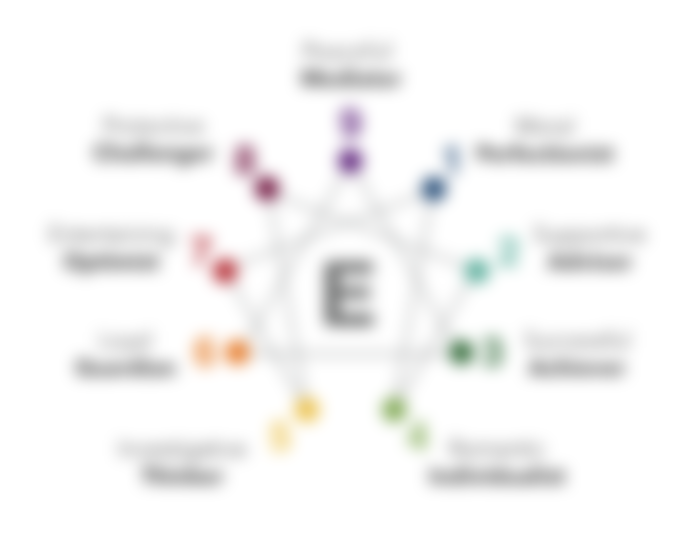I am here again with a long and interesting article that you will pray. Enneagram personality types model in its simplest form is a typology system that defines character through several interrelated personality types. Although it is a model that is frequently used as a personality test, especially in the wellness world and organizations, it should be underlined that it is not accepted as a valid model as other personality models due to the limited evidence-based research on the Enneagram personality model in psychology.

The Enneagram personality types model is represented by a diagram consisting of 9 interconnected points. Each of the 9 separate points in the diagram represents a personality type. The Enneagram diagram, which consists of 9 personality types, also consists of 3 different elements. The first element on the outside of the figure is a circle connecting all the dots, the second element is a triangle inside the circle connecting personality types 3-6-9, and the third element is with lines connecting personality types 1-4-2-8-5-7. forms an irregular hexagonal shape.

By placing the basic nine personality types included in the enneagram diagram into the three-element diagram, the system becomes much more complex and creates three key “centers” that focus on 27 different sub-personality types as well as behavior, emotion, and thought.
Although it remains a mystery how and by whom the Enneagram personality type model was first created, various sources indicate that this personality classification first appeared in ancient Greece; He suggests that it has reached the present day, synthesized with the teachings of religions such as Christianity, Judaism, Buddhism and Hinduism.

Although George Ivanovich Gurdjieff is the name that brought the Enneagram personality type model to the western world and made it popular, the first person to use this model in terms of personality classification was Oscar Ichazo, known for his potential and personal development. In the later period, psychiatrist Claudio Naranjo expanded the theory of Enneagram personality type model and brought the 9 personality types under this model to the world of psychology with a psychological framework.
How are Enneagram personality types determined?
Each of the 9 personality types that make up the Enneagram personality types model contains various dominant behavioral patterns, motivational factors, and things that the person is afraid of. Personality analysis made according to this system aims to determine the personality type of the individual and to realize his / her strengths and weaknesses and to realize his / her potential in this direction.

Basic personality type
According to the Enneagram Theory, each of us has a dominant personality type that we are born with, and this personality type that we are born with can take shape and change over time, through environmental factors and our experiences. Since our experiences in the external world and our innate character traits are in constant interaction with each other, on the one hand, our character traits determine our reactions to our experiences, on the other hand, our reactions to our experiences mediate the shaping of our personality and behavior.

Sub personality types
Although the Enneagram system suggests that a personality type is more dominant in all of us, it says that our personality is not only composed of this dominant type, but a whole of different sub-personality types. According to the Enneagram personality types model, each of us has a basic personality type as well as at least one or more sub-personality types that have a significant impact on our entire character, but not so dominant enough to change our basic personality type.
According to the Enneagram theory, it is not possible for us to switch from our dominant basic personality type to another personality type. However, since this dominant personality type and all the factors related to the subtypes of our personality can show temporal and situational differences according to our health status, well-being, habits and preferences; It can be quite difficult for us to understand what personality type we have by simply observing our behavior or attitudes.
Although the Enneagram personality test is not the most reliable way to find out which personality type you have, it contains all the information you need to understand your dominant personality type and define your personality in the best possible way. With the Enneagram personality test, it is possible to discover your sub-personality types that affect your dominant personality as well as your dominant personality type.

While each of the nine character types that make up the enneagram diagram and personality model is known by both their numbers and names, each also has its own potential strengths and weaknesses.
Type 1: Innovative / perfectionist
It is extremely dependent on its rules and principles. For this reason, they can often be judgmental and show uncompromising attitudes. Throughout his life, he is a perfectionist in all his responsibilities and jobs. As he prefers to move towards a goal, he can easily control his impulses and emotions while moving towards his goals. It attaches importance to honesty and integrity. His biggest fear is lies, injustice, and direct deviation. He can analyze very well the right and wrong ways of doing any job.

Type 2: Benefactor / donor
It has a very generous character and can therefore always please the people around him. He has a strong passion for being loved and accepted by others. Often times, they may ignore even their most basic needs in order to make other people happy. He puts an incredible energy into his relationships, but being so connected and concerned with others can at times be perceived by the people around him as in need of his relationships. He is sincere and sincere in his behavior. He is a good listener. He can easily feel exhausted and tired because he ignores his own needs.

Type 3: Success / performance oriented
Regardless of the work he does, he is at the forefront of achieving success as a result. It has a harmonious character and is very hardworking. Sometimes he can be a workaholic because he focuses on being successful in every job even though he doesn't need it. Continuously exhibits progress and development oriented attitudes. It gives importance to how it looks and is perceived from the outside. He can ignore his feelings and desires in order to be successful. He is good at communication.

Type 4: Individual / unique
It has creative ideas and a forward-thinking character. He can express his feelings and thoughts very well. Sometimes he can be self-centered and put his own wants and needs before everything else. Identity and self-awareness are extremely high. He can easily be touched and isolate himself from other people in order to experience his emotions freely.

Type 5: Researcher / observer
It is innovative and forward-thinking. Their perceptions and intuitions are very clear. Makes extremely smart and logical decisions. He examines every subject thoroughly, attaches importance to details and thinks very deeply. Often seems silent and thoughtful. It evaluates the decisions it makes with an objective perspective and generally acts with its logic in decision-making processes. Therefore, it may seem callous and apathetic.

Type 6: Loyal / skeptical
Responsibility awareness is extremely high. He tries to complete each responsibility and task in the best possible way by dedicating himself. Usually it builds long lasting, strong and solid relationships. He is respected in all his relationships for his reliability, loyalty and dedication. Sometimes it can be overly worried. He tends to see events and situations constantly from the negative side and focus on the negative.

Type 7: Curious / adventurous
He likes to live spontaneously and enjoy the moment. He is extroverted in his relationships. He enjoys socializing and meeting new people. Besides loving adventure and the unknown, he always searches and finds a way to have fun. He is easily distracted and may have trouble focusing. He thinks fast and superficially. He always approaches events and situations with a positive perspective; is optimistic.

Type 8: Defiant / guardian
It has a tough, dominant, confrontational and challenging character. He stands firmly behind every decision he makes and is extremely confident. Shows success in any job that requires leadership. Due to its inflexible, dominant character, it can overwhelm the people around it and exhibit aggressive attitudes. He does not hesitate to express his thoughts as they are. He prefers to be clear and act rather than speak unnecessarily.

Type 9: Peaceful / mediator
It has a character that is extremely harmonious and easy to understand. From time to time, he may exhibit attitudes that show that he is arrogant and indifferent to the person he is facing. He tries to avoid conflict and disagreement as much as possible. It makes an effort to harmonize the other members of the group in which it is included. He doesn't like disagreements, quarrels, and disagreements with others. He can put his wants and needs in the second plan in order to create a peaceful and peaceful environment for himself.

What is it good to know about Enneagram personality types?
Enneagram personality typology is used to classify individuals according to the 9 character traits listed above. The aim is not only to enable the individual to gain insight into their own personality, but also to give clues about how to better relate to other people and the outside world, and to help the person realize their potential.

Although the scientific studies on Enneagram personality types and the evidence on their effectiveness are not yet at a sufficient level, it is one of the most important reasons for this approach to become popular when it is used as a tool to get to know oneself better and establish better relationships. The Enneagram personality types model, which allows an individual to gain insight into their strengths and weaknesses, can be extremely useful in recognizing our common traits with other people and developing strategies to communicate effectively.
Enneagram personality types test
Enneagram is often thought of as a tool for self-analysis and self-improvement, as it allows us to see our strengths as well as our mistakes and weaknesses. It can guide us about the steps we need to take to realize our potential, as well as to better know our strengths and weaknesses, our development areas, and contribute to our self-awareness.
Personality contains highly complex processes and concepts; Therefore, it is not possible to make sense of personality and to fit it into a frame, even with the most valid and reliable methods. Although the Enneagram test helps you gain insight into yourself; Like every personality test, it will not be sufficient to make a definite inference about your character, motivations, behavior, strengths and weaknesses.
While it may be fun to solve these kinds of personality tests and make inferences about yourself, we also want to remind you that you should not put yourself in stereotypes and labels by taking the results too seriously.
Although the personality of every person in the world is unique and unique, it is important to learn what constitutes personality, why personality models are needed, and why it is important to know which personality type we have through personality tests.















